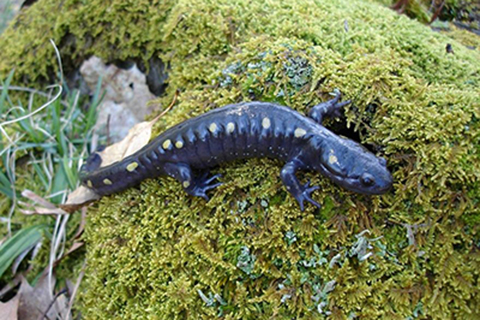DCNR manages about 2.5 million acres of public lands on behalf of all Pennsylvanians. As part of its mission, the department looks to incorporate sustainable management practices to do the right thing, and also demonstrate those practices to the public.
Under a strategic initiative on water, the department has a goal of conserving, protecting, and restoring surface water resources and aquatic ecosystems on DCNR lands.
Did you know that the cleanest water comes from forested landscapes?
DCNR’s Bureau of Forestry has special projects underway in some places on state forest land to strategically add woody material to streams to provide aquatic habitat and improve floodplains.
What are floodplains?
Floodplains are flat lands adjacent to streams and rivers formed by sediment deposits, flooding, and erosion. Floodplains and streams are interconnected and important to a forest.
Under natural conditions, streams meander across floodplains and may form braided channels, crisscrossing each other. A floodplain allows high waters from a stream to spread out, slow down, and drop sediment.
The sediment load of the stream is reduced so it does not smother delicate fish habitat. The flood water then percolates through the soil and may result in a higher water table. This leads to lower flood peaks and higher base flow in the stream between precipitation events.
Healthy floodplains have more stable streams, which protect downstream infrastructure, such as bridges and cabins.
In the past, people “channelized” streams, straightening out their pathway and moving floodwater downstream quickly. This has caused problems downstream, removing water from the water table, causing higher flood events and more erosion.
Many of our current streams have been disconnected from their floodplains by either channelizing or by legacy sediments, silt, and sand left behind from mill dams during colonial times.
The addition of large woody material to streams can slow the water and force it onto the floodplain, while woody material on the floodplain slows the flood water even more allowing sediment to drop out. The water stays in the floodplain longer, allowing for infiltration and erosion reduction.
How is DCNR working to improve stream habitat?
This year in the Michaux State Forest in Cumberland County, a six-person crew treated 300 feet of Mountain Creek with large woody material to improve stream habitat.
DCNR used a GP-1 permit from the Pennsylvania Fish and Boat Commission and Department of Environmental Protection for the project. This is the first time this has been done in Pennsylvania.
Four “structures” consisting of eight trees cut into the stream. The project took two hours to complete, and required no equipment and no ground disturbance. The cost was also considerably less than doing the same project using the typical artificial engineered structures.
DCNR has seen water distributed across the floodplain adjacent to the treated stream section. An area of about 600 feet by 100 feet was inundated during a high-water event, and no water reached the floodplain.
Floodplain benefits

A healthy forest floodplain supports many ecosystem functions. Floodplains are wildlife habitat, used by many forest, aquatic, and avian species.
Salamanders, frogs, toads, and turtles all use the moist soil and stream edge. Song-birds, especially the Louisiana waterthrush, and mammals such as raccoons, mink, and water shrews are commonly found in floodplains.
Common floodplain trees include:
- Yellow birch
- Hemlock
- Red maple
- Silver maple
- Ash
- Sycamore
- Black willow
- Elm
- Basswood
To learn more about the animals that enjoy moist soil in our state parks and forests, find an upcoming DCNR educational event near you.
If you are a landowner with forest on your property and are interested in assistance with sustainable management, contact your local DCNR service forester.